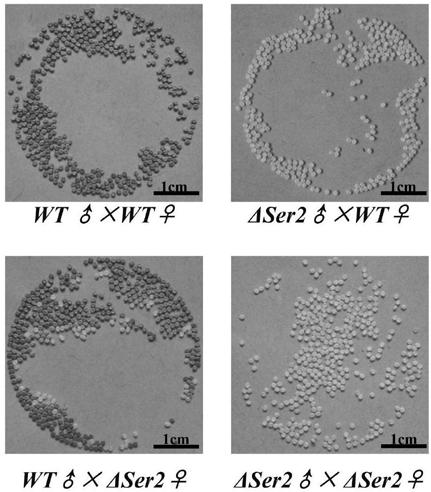Preparation method and nucleic acid construct of male sterile lepidoptera insects
A technology of lepidopteran insects and nucleic acid constructs, applied in the field of a method of lepidopteran insects and its nucleic acid constructs, can solve problems such as not being male, and achieve the effect of promoting development and realizing controllability
- Summary
- Abstract
- Description
- Claims
- Application Information
AI Technical Summary
Problems solved by technology
Method used
Image
Examples
Embodiment 1
[0046] The construction of embodiment 1 carrier
[0047] 1. The BmSer2 knockout plasmid PXL-BacII-IE1-DsRed2-U6-BmSer2sgRNA1-U6-BmSer2sgRNA2 was cloned by PCR method. Specific steps:
[0048]I. sgRNA-KnpI-F and sgRNA-R1, sgRNA-F1 and sgRNA-Overlap-R two pairs of primers respectively use the PXL-BacII-IE1-DsRed2-U6-U6 plasmid as a template to obtain the product by PCR, and then the product is 2 The volume ratio of :1 was used as a template, and sgRNA-KnpI-F and sgRNA-Overlap-R were used as primers to obtain the BmSer2sgRNA-1 fragment with restriction endonuclease KnpI homology arms by PCR. Similarly, use sgRNA-Overlap-F and sgRNA-R2, sgRNA-F2 and sgRNA-HindIII-R as the first round of PCR primers, and after the product is obtained, use sgRNA-Overlap-F and sgRNA-HindIII-R as the second round Primers, BmSer2sgRNA-2 fragments with restriction endonuclease HindIII homology arms were obtained by PCR.
[0049] Finally, the pXL-BacII-IE1-DsRed2-U6-U6 plasmid was digested with restri...
Embodiment 2
[0065] The acquisition of embodiment 2 transgenic silkworm
[0066] The Ser2 knockout plasmid PXL-BacII-IE1-DsRed2-U6-BmSer2sgRNA1-U6-BmSer2sgRNA2 prepared in Example 1 and the plasmid PHA3PIG capable of expressing Piggybac transposase were mixed in equal amounts and injected into silkworm primiparous eggs. The injection method was microinjection according to the method described by Kanda﹠Tamura (1991). After injection, it was sealed with non-toxic glue to prevent contamination, and then hatched in a sterile environment at 25°C, and the ant silkworm was reared. After mothization, the contemporary (G0 generation) silkworm moth was selfed, and the G1 generation ant silkworm obtained in the fluorescent The individual transgenic silkworms with red fluorescence were screened under a microscope (ie, the BmSer2 mutant intermediate strain).
[0067] Subsequently, the screened red fluorescent transgenic silkworm and green fluorescent transgenic silkworm Nos-Cas9 were reared and mated,...
Embodiment 3
[0068] The detection of embodiment 3 transgenic silkworms
[0069] Identification of gene mutations: 10 double fluorescent silkworms were selected during the ant silkworm stage to extract their genomes, using primers F1 and R1, F2 and R2, the target fragments were cloned by PCR and sequenced. Sequencing results showed that both "target 1" and "target 2" sequences were mutated in the BmSer2 gene in the double fluorescent silkworm.
[0070] Situation of eggs laid by double-fluorescent silkworms: 30 single-sex double-fluorescent silkworms were mated with wild-type silkworms at an ambient temperature of 25°C for 5 hours, then separated for 5 hours, and then laid eggs in the same environment for 36 hours, and the number of eggs laid and hatched were counted rate, see Figure 2. It can be seen that the hatching rate of eggs laid by BmSer2 mutation (i.e. double fluorescence) female silkworm and normal male silkworm is normal; the hatchability of eggs laid by BmSer2 mutation (i.e. dou...
PUM
 Login to View More
Login to View More Abstract
Description
Claims
Application Information
 Login to View More
Login to View More - R&D
- Intellectual Property
- Life Sciences
- Materials
- Tech Scout
- Unparalleled Data Quality
- Higher Quality Content
- 60% Fewer Hallucinations
Browse by: Latest US Patents, China's latest patents, Technical Efficacy Thesaurus, Application Domain, Technology Topic, Popular Technical Reports.
© 2025 PatSnap. All rights reserved.Legal|Privacy policy|Modern Slavery Act Transparency Statement|Sitemap|About US| Contact US: help@patsnap.com



